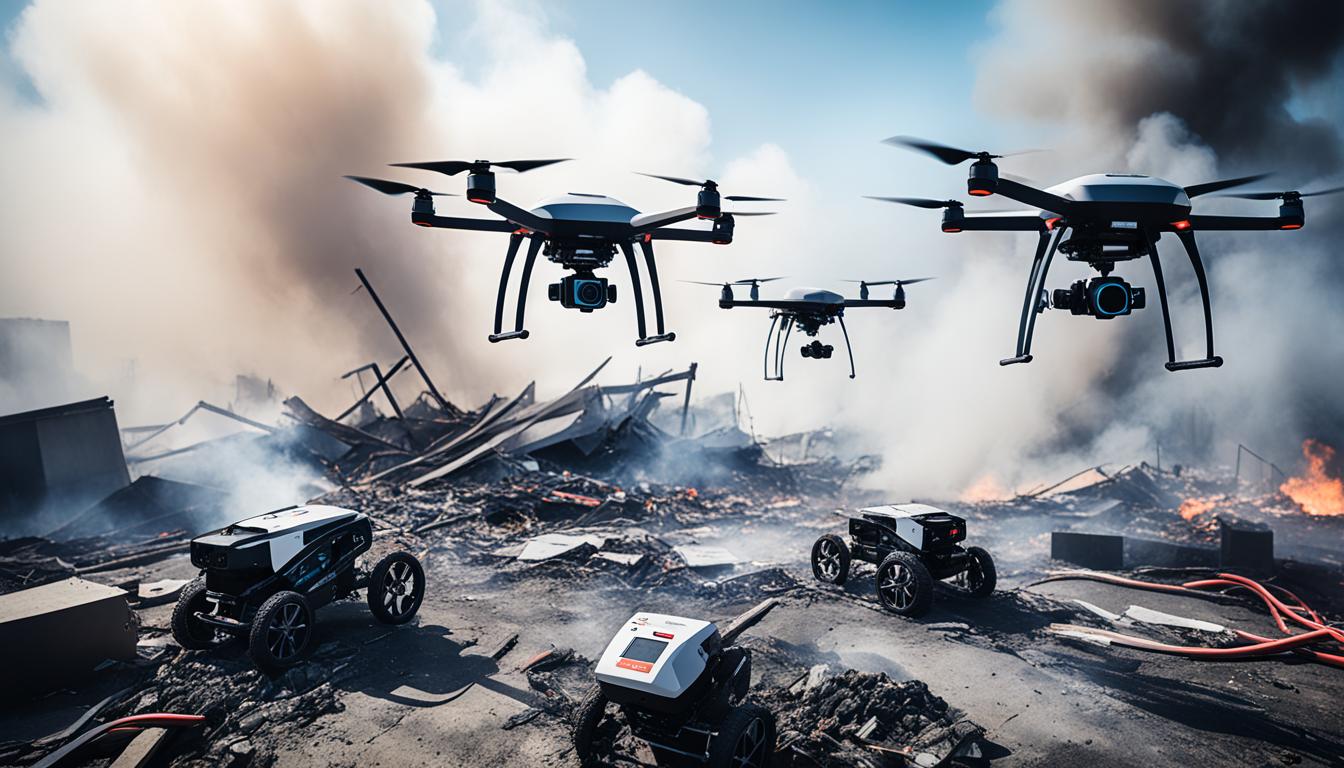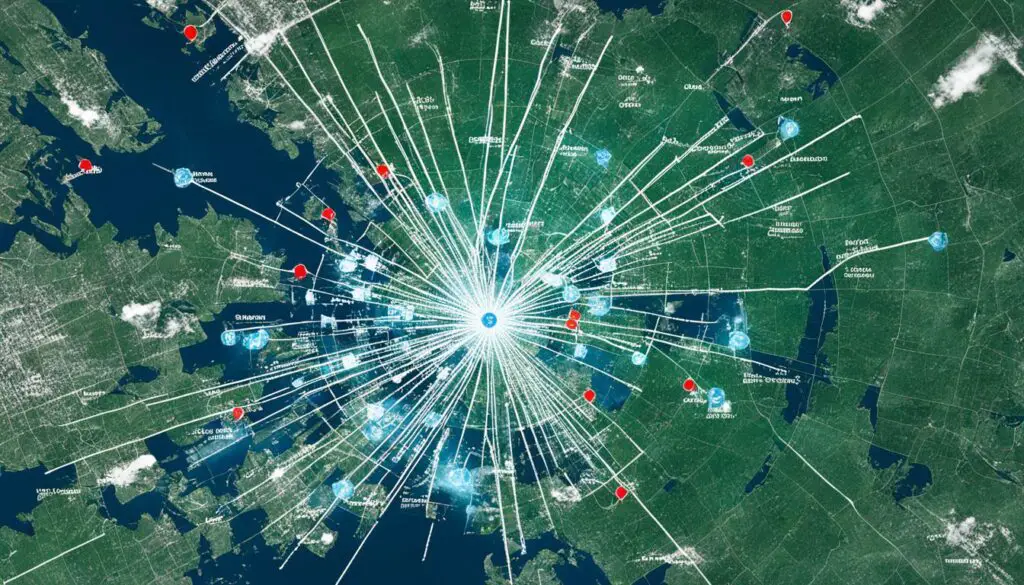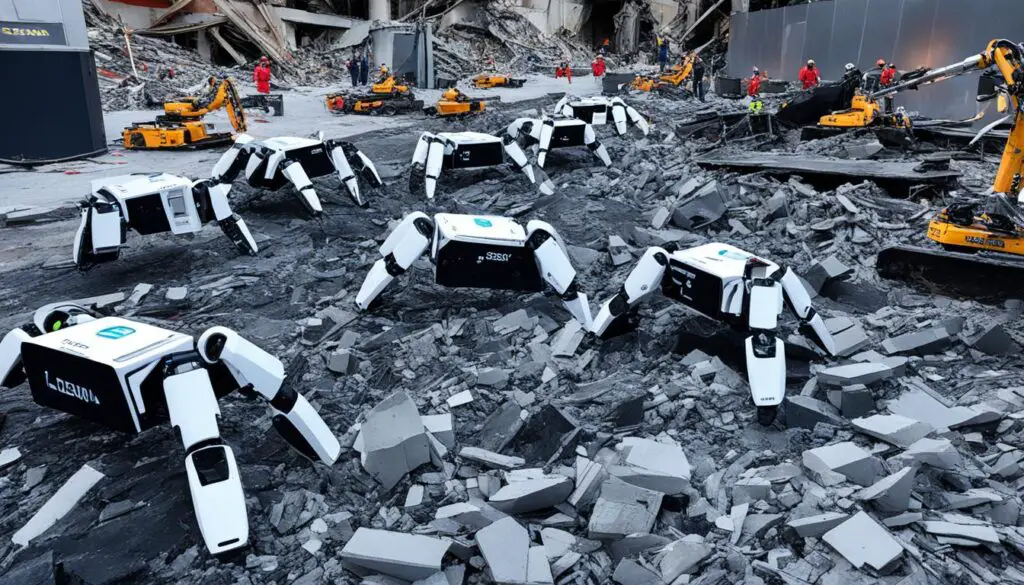
As natural disasters become more common and severe, we need quick and efficient emergency responses. Thankfully, Artificial Intelligence (AI) has improved disaster relief efforts. It has made them faster and more effective.
AI helps by analyzing large data sets and making smart predictions. This is a big help in managing emergencies. It assesses damage and predicts disasters before they happen, changing how we handle crises.
The xView2 project, backed by the US Department of Defense, is a great example of AI at work. It uses machine learning and satellite images to quickly see and evaluate damage from disasters. This tool has helped in areas hit by earthquakes, floods, and wildfires.
AI-driven systems give early warnings about potential disasters. This lets people evacuate in time and helps manage resources well. Robots with AI and various sensors are also speeding up search and rescue, helping find survivors faster.
To improve communication during emergencies, AI chatbots answer many questions. They give updates on emergency steps, safe exits, and safety tips. These chatbots are available 24/7. They take the load off emergency call centers and make sure people get the information they need right away.
AI’s role in emergency response is changing the game. It helps by giving early warnings, making rescues faster, and spreading vital information. This is making communities safer and more prepared for disasters.
Key Takeaways:
- AI is improving the speed and effectiveness of disaster relief efforts.
- xView2 project uses AI and satellite imagery for real-time damage assessment.
- AI-driven early warning systems provide advanced notice for evacuations.
- Robotic assistants equipped with AI are aiding in search and rescue operations.
- AI chatbots are providing real-time information and relieving pressure on emergency call centers.
Early Warning Systems and Predictive Analytics
AI is changing how we handle emergencies by introducing early warning systems and predictive analytics. These tools predict disasters and help save lives by letting authorities make smart choices. They use vast data to give a heads-up, guiding the effective use of resources.
Machine learning helps these AI systems predict danger by examining different data sources. Weather patterns and earthquakes are some examples. This helps spot high-risk areas early, giving time for a better response.
AI’s role in emergency planning is crucial for managing resources during a crisis. It uses past data and current facts to predict which areas will need help. Things like how many people live there and how strong the buildings are, matter. This means help can arrive faster and more ready.

“The integration of AI and predictive analytics in emergency response not only saves lives but also helps create resilient communities that are better prepared for future disasters.”
Emergency teams are getting better at what they do with AI early warning systems. These tools let them get ready before a disaster strikes. This means less damage and quicker recovery for communities.
| Benefits of AI Early Warning Systems and Predictive Analytics | Impact on Emergency Response |
|---|---|
| Advanced notice and early detection of potential disasters | Enables timely evacuation and proactive resource allocation |
| Accurate forecasting of high-risk areas | Optimizes positioning of personnel, equipment, and supplies |
| Minimizes loss of life and property damage | Facilitates a faster and more efficient response |
| Enhances community resilience | Improves preparedness for future disasters |
Real-Life Example: AI in Hurricane Forecasting
The NOAA uses AI for better hurricane forecasts. They look at past storms, weather, and the sea to predict hurricanes. This leads to quicker warnings, evacuations, and deploying help. It’s a big help in saving lives.
As AI gets better, it will play a bigger role in protecting us from disasters. Early warning and predictive analytics will make communities safer and more prepared.
Robotic Assistance and Chatbots in Emergency Response
AI-driven robots with sensors and cameras are crucial in disasters. They navigate dangerous areas to find survivors. These robots send vital info to emergency teams, speeding up rescues and saving lives.
AI robots are key in earthquake zones. They reach places like collapsed buildings, avoiding human risks. With AI and technology, they detect life and inform human teams.
AI chatbots are also improving emergency communications. They manage many questions and give updates on safety and evacuations. Available 24/7, they help keep emergency lines open and provide accurate advice during crises.
AI-driven robots and chatbots are revolutionizing emergency response by leveraging their unique capabilities to enhance search and rescue operations and facilitate effective communication.
In disasters, call centers get overwhelmed quickly. AI chatbots shine here. They handle many chats at once, giving correct and constant info, freeing up people for urgent tasks. This makes emergency response quicker and more effective.
AI chatbots adapt to specific disasters too. For wildfires, they offer safe zone info, shelter locations, and fire updates. During earthquakes, they advise on safety actions and can connect people to help.
The Future of AI in Emergency Response
The use of AI in emergency response is just starting. As tech improves, so will AI tools. New sensors and AI will help robots make quick decisions in complex situations.
Chatbots will understand and react to human language better. This means they can comfort and guide those in distress more effectively during emergencies.
With AI leading the way, our capacity to save lives and inform communities will grow. AI brings the promise of stronger, safer communities ready for future challenges.

Harnessing AI for Safer Communities
AI is changing the way we get ready for and handle disasters. It uses advanced algorithms and real-time data. This helps make communities stronger and saves lives.
AI provides early warnings by looking at weather and other data. This lets us act early, saving communities from harm. It means we can evacuate people and get resources ready quickly.
AI also helps manage where resources go during a crisis. It uses algorithms to figure out where help is needed most. This makes emergency responses faster and more effective.
Moreover, AI is important in search and rescue missions. Robots with cameras and sensors help find survivors. AI chatbots also help by answering questions, making it easier for emergency teams.
As AI gets better, it becomes even more helpful in emergencies. It gives us early warnings, makes resource use better, and aids in rescues. AI is a key tool for safer communities.
Using AI helps communities face and prepare for disasters better. As AI improves, it will keep making emergency management better. This leads to safer and more prepared communities.
FAQ
How is AI being used in emergency response?
Can you provide an example of AI in emergency response?
How are early warning systems and predictive analytics powered by AI beneficial in emergency response?
How are AI-driven robots and chatbots being used in emergency response?
What is the role of AI in creating safer communities?
Source Links
- https://www.technologyreview.com/2023/02/20/1068824/ai-actually-helpful-disaster-response-turkey-syria-earthquake/
- https://www.linkedin.com/pulse/rapid-response-revolution-how-ai-transforming-crises-rama-chintakunta-17bjc
- https://aiforgood.itu.int/event/robots-saving-lives-in-disaster-hit-areas/






